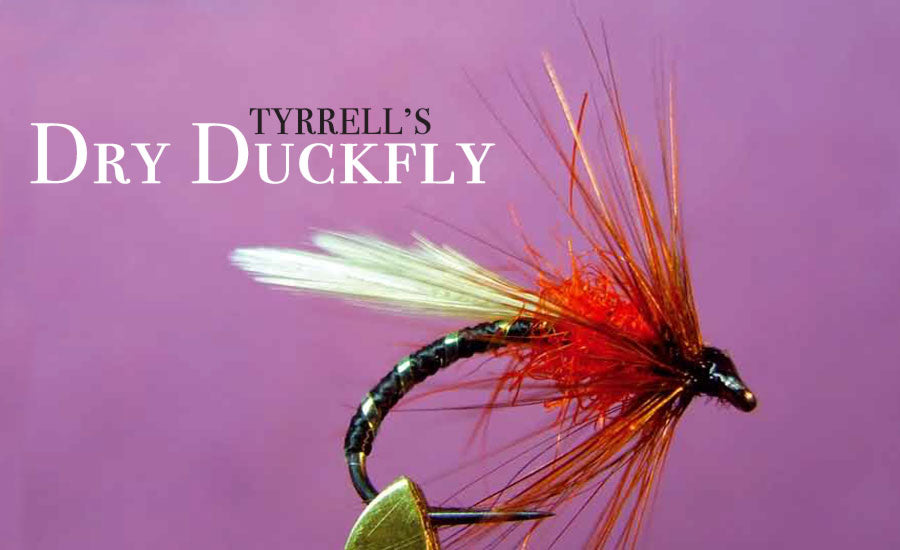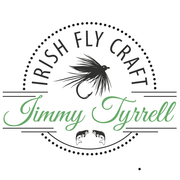Tyrrell's Dry Duckfly - Irish Angler Magazine January 2012
- by James Tyrrell
-

Jimmy Tyrrell shares a dry duckfly pattern that he came across quite a few years ago and which is probably the only dry pattern that he ties, as there is normally more demand for the wet style.
I can’t even recall where I came across the tying for the fly as it was quite a few years ago, but it is a tried and tested fly pattern that I have tied up for many anglers with good success on the western loughs. It pays to carry a few wet and dry patterns in your fly box as conditions can dictate which fly to use. This pattern can be altered to imitate the wet fly quite simply by just using a soft hen hackle for the wet pattern.
The duckfly hatch runs from around mid-March – traditionally Paddy’s Day – into April, and great sport can be had if you can have the right fly on the day. You need some local knowledge too, as it does not occur on every part of the lough, so it’s best to try to get some information on where the hatches might happen. There can be some very big hatches. The insects tend to emerge from the deeper water so at times fishing from the shore can be out of reach.
"The thing that I particularly like about this pattern is that it sits perfectly on the surface with abdomen of the fly sitting just under the surface and the hackle holding it on the surface."

The main hatches normally take place in the afternoon trout feed mainly on the pupae as they are coming to the surface and on duck fly that are suspended in the surface film while they are hatching. That is why I like this dry pattern for the insect tied on a grub hook as the body of the fly sits perfectly in the surface film, and acts as if the fly is coming through to the surface. The dry duckfly will work better in calmer conditions, as the insects tend to stay on the water that bit longer and when trout are cruising around feeding on the pupae the dry can bring some good fishing.
The thing that I particularly like about this pattern is that it sits perfectly on the surface with abdomen of the fly sitting just under the surface and the hackle holding it on the surface. The tying is pretty straightforward, requiring just black tying thread, pearl flash for the rib, hot orange seal’s fur, a good quality fiery brown hackle and two white or cream hackle tips for the wings. The wet pattern can be tied in almost the same way, just omit the fiery brown hackle and add a soft black hen hackle at the head, and maybe a turn of grey partridge in front of the black hackle.
Tyrrell's Dry Duckfly
| Hook: | Size 12 fine wire grub |
| Rib: | One strand Pearl Flash or fine silver wire |
| Body: | Black tying thread |
| Wings | Two white hackle tips tied back to back, dull side |
| Thorax: | Facing inwards |
| Hackle: | Hot orange seal’s fur Good fiery brown cock |
Tying Instructions
 Step One:Tie on the thread, wind to around the bend and tie in the rib.
Step One:Tie on the thread, wind to around the bend and tie in the rib. Step Two:Wind the tying thread back up to form the body.
Step Two:Wind the tying thread back up to form the body. Step Three:Wind up the rib and catch in.
Step Three:Wind up the rib and catch in. Step Four:Tie in the hackle tips sloping back to create the wing.
Step Four:Tie in the hackle tips sloping back to create the wing. Step Five:Dub on a pinch of seal’s fur.
Step Five:Dub on a pinch of seal’s fur. Step Six:Build up the thorax, making a nice oval shape.
Step Six:Build up the thorax, making a nice oval shape. Step Seven:Tie in the cock hackle.
Step Seven:Tie in the cock hackle. Step Eight:Wind on the hackle five or six turns and catch in.
Step Eight:Wind on the hackle five or six turns and catch in. Step Nine: Whip finish and varnish.
Step Nine: Whip finish and varnish.Tying Tips
Tip 1: Keep the body nice and slim giving it a slight taper.
TIP 2: Don’t overdo the head hackle – five or six turns is plenty.
TIP 3: Keep the seal’s fur is nice and tight on the thorax and pluck out some fibres with a dubbing needle.
TIP 4: Don’t have the wings extended to far past the body, keep them fairly short.





